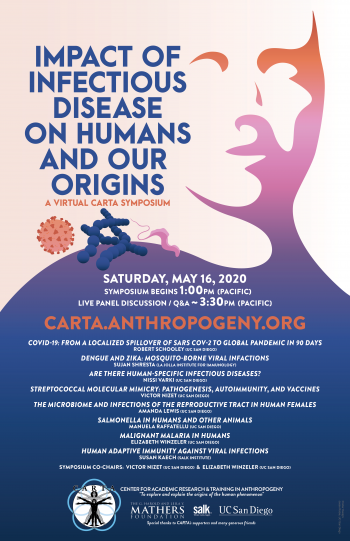Impact of Infectious Disease on Humans & Our Origins
Victor Nizet, UC San Diego
Elizabeth Winzeler, UC San Diego
Summary:
As the COVID-19 pandemic illustrates, infectious diseases can have profound influences on their host populations. Human evolution has unquestionably been shaped by past infections. However, humans have also shaped pathogen dynamics and virulence via a multitude of factors. Some ancient human influences range from changes in social organization, group size, and the exploitation of more varied ecosystems. More recently, developments such as settlement, agriculture, technology, rapid long-distance travel, medicine, and global economic integration, continue to shape epidemics and the human host populations. The goal of this public symposium is to explore how infectious agents and humans shape each other’s evolutionary trajectories.
Media for each talk can be played by clicking on icons in the table below, or by clicking on the individual talk titles below and then the attachment file at the bottom of the page.
| Speakers | Media | Session |
|---|---|---|
 Pascal Gagneux |
|
Welcome & Opening Remarks |
 Robert (Chip) Schooley |
|
SARS CoV2: A Third Coronavirus Takes to the Air Over the past two decades novel coronaviruses have spilled from the bat to the human population on three occasions. The first two breakouts in south China in 2003 and in Saudi Arabia in 2012 launched the SARS and MERS outbreaks, respectively. Both outbreaks were contained by aggressive case finding, contact tracing and quarantine activities. A third crossover of a novel coronavirus into the human population occurred in the fall of 2019. This event which is believed to have occurred around a wet... read more |
 Sujan Shresta |
|
Dengue and Zika: Mosquito-borne viral infections The four dengue virus serotypes and Zika are closely related RNA viruses that share the same mosquito vector and circulate in overlapping geographic ranges. Due to urbanization and climate change, dengue- and Zika-transmitting mosquitos are expanding their habitat, and these viruses now pose significant threats to global health, affecting over half the world’s population. Due to their phylogenetic and antigenic relatedness, the immune response to dengue and Zika viruses are highly cross-... read more |
 Nissi Varki |
|
Are there human-specific infectious diseases? Although humans are genetically very similar to the evolutionarily-related nonhuman hominids (chimpanzees, bonobos, gorillas, and orangutans), comparative studies suggest a surprising number of distinctly human differences in the incidence and/or severity of biomedical conditions. Some differences are due to anatomical changes that occurred during human evolution. However, many others cannot be explained either by these changes or by known environmental factors. There are a number of Distinctly... read more |
 Victor Nizet |
|
Streptococcal molecular mimicry: Pathogenesis, autoimmunity, and vaccines Group A Streptococcus (GAS) and Group B Streptococcus (GBS) are two of the most important human leading human bacterial pathogens. GAS is the cause of “strep throat”, with 700 million cases per year globally, but also has the potential to produce severe invasive diseases including necrotizing fasciitis (“flesh-eating disease”) and toxic shock syndrome, even in previously healthy individuals. GBS colonizes the lower GI tract and vaginal epithelium in healthy women, but can cause severe... read more |
 Amanda Lewis |
|
The microbiome and infections of the reproductive tract in human females This talk will focus on the human vaginal microbiome and infections of the female reproductive tract. The microbiome plays key roles in human physiology and while understudied, the female reproductive tract is no exception. In women, the vaginal microbiome can fall into one of two categories, broadly speaking. The first is dominated by Lactobacillus, usually L. crispatus or L. iners. The second is a diverse microbiome containing both a wider variation in species content, as well as an overall... read more |
 Manuela Raffatellu |
|
Salmonella in humans and other animals Salmonella enterica is a Gram-negative enteric pathogen that is responsible for over 120 million cases of infection world-wide. The species can be divided in six subspecies, and comprise over 2,000 serovars. The vast majority of Salmonella serovars can colonize a variety of hosts, including farm animals (chicken, cattle, pigs) that often transmit the infection to humans. A few serovars, however, are restricted to the human host, thus only colonize and infect humans. The first group of serovars... read more |
 Elizabeth Winzeler |
|
Malignant malaria in humans Malaria, which is caused by parasitic protozoa and spread by mosquitos, remains a devasting infectious disease that endangers 40% of the world’s population. In 2018 there were almost with almost a quarter billion annual cases and a half million deaths. However, before the discovery of antimalarial treatments, is estimated that, up to 20% of children would have died from malaria, putting strong selective on the human genome. I will discuss how many modern humans carry genetic signatures that... read more |
 Susan Kaech |
|
Human adaptive immunity against viral infections Memory CD8 T cells arise following infection from a heterogenous population of effector T cells that contains cells of various differentiation states. Many of these effector CD8 T cells develop into end-stage terminal effector cells that die following infection and a smaller portion develops into cells with greater memory cell potential and longevity. Understanding how effector CD8 T cell differentiation is regulated to generate cells of diverse cell fates is important and much progress has... read more |
 All Speakers |
|
Audience Questions & Answers |
| Attachment | Size |
|---|---|
| 563.02 KB | |
| 6.51 MB | |
| 264.09 KB |
If you enjoy this event, please consider supporting CARTA's quest to explore and explain the human phenomenon.


